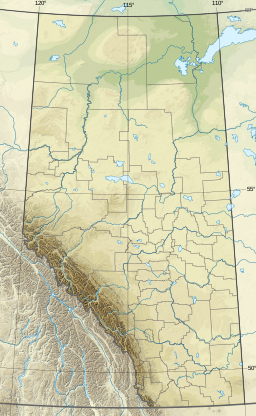
The Blackfoot Confederacy, Niitsitapi, or Siksikaitsitapi, is a historic collective name for linguistically related groups that make up the Blackfoot or Blackfeet people: the Siksika ("Blackfoot"), the Kainai or Blood, and two sections of the Peigan or Piikani – the Northern Piikani (Aapátohsipikáni) and the Southern Piikani. Broader definitions include groups such as the Tsúùtínà (Sarcee) and A'aninin who spoke quite different languages but allied with or joined the Blackfoot Confederacy.
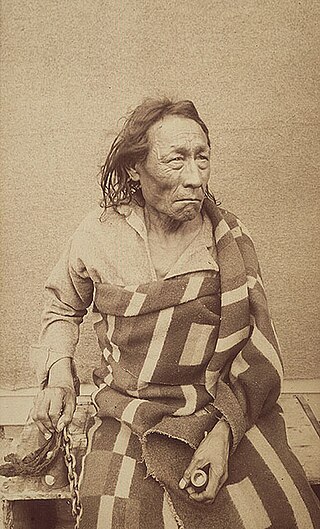
Big Bear, also known as Mistahi-maskwa, was a powerful and popular Cree chief who played many pivotal roles in Canadian history. He was appointed to chief of his band at the age of 40 upon the death of his father, Black Powder, under his father's harmonious and inclusive rule which directly impacted his own leadership. Big Bear is most notable for his involvement in Treaty 6 and the 1885 North-West Rebellion; he was one of the few chief leaders who objected to the signing of the treaty with the Canadian government. He felt that signing the treaty would ultimately have devastating effects on his nation as well as other Indigenous nations. This included losing the free nomadic lifestyle that his nation and others were accustomed to. Big Bear also took part in one of the last major battles between the Cree and the Blackfoot nations. He was one of the leaders to lead his people against the last, largest battle on the Canadian Plains.

Rocky Boy's Indian Reservation is one of seven Native American reservations in the U.S. state of Montana. Established by an act of Congress on September 7, 1916, it was named after Ahsiniiwin, the chief of the Chippewa band, who had died a few months earlier. It was established for landless Chippewa (Ojibwe) Indians in the American West, but within a short period of time many Cree (Nēhiyaw) and Métis were also settled there. Today the Cree outnumber the Chippewa on the reservation. The Bureau of Indian Affairs (BIA) recognizes it as the Chippewa Cree Reservation.
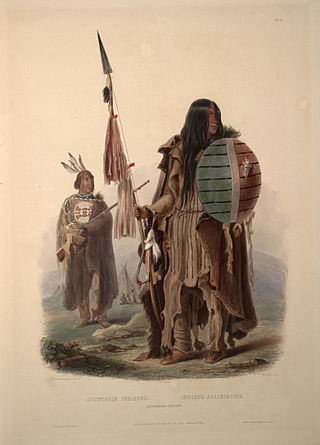
The Assiniboine or Assiniboin people, also known as the Hohe and known by the endonym Nakota, are a First Nations/Native American people originally from the Northern Great Plains of North America.
First Nations in Alberta are a group of people who live in the Canadian province of Alberta. The First Nations are peoples recognized as Indigenous peoples or Plains Indians in Canada excluding the Inuit and the Métis. According to the 2011 Census, a population of 116,670 Albertans self-identified as First Nations. Specifically there were 96,730 First Nations people with registered Indian Status and 19,945 First Nations people without registered Indian Status. Alberta has the third largest First Nations population among the provinces and territories. From this total population, 47.3% of the population lives on an Indian reserve and the other 52.7% live in urban centres. According to the 2011 Census, the First Nations population in Edmonton totalled at 31,780, which is the second highest for any city in Canada. The First Nations population in Calgary, in reference to the 2011 Census, totalled at 17,040. There are 48 First Nations or "bands" in Alberta, belonging to nine different ethnic groups or "tribes" based on their ancestral languages.
Treaty Five is a treaty between Queen Victoria and Saulteaux and Swampy Cree non-treaty band governments and peoples around Lake Winnipeg in the District of Keewatin. Much of what is today central and northern Manitoba was covered by the treaty, as were a few small adjoining portions of the present-day provinces of Saskatchewan and Ontario.
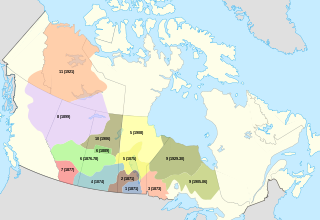
Treaty 6 is the sixth of the numbered treaties that were signed by the Canadian Crown and various First Nations between 1871 and 1877. It is one of a total of 11 numbered treaties signed between the Canadian Crown and First Nations. Specifically, Treaty 6 is an agreement between the Crown and the Plains and Woods Cree, Assiniboine, and other band governments at Fort Carlton and Fort Pitt. Key figures, representing the Crown, involved in the negotiations were Alexander Morris, Lieutenant Governor of the North-West Territories; James McKay, The Minister of Agriculture for Manitoba; and W.J. Christie, the Chief Factor of the Hudson's Bay Company. Chief Mistawasis and Chief Ahtahkakoop represented the Carlton Cree.
Anthony Henday was one of the first Europeans to explore the interior of what would eventually become western Canada. He ventured farther westward than any white man had before him. As an employee of the Hudson's Bay Company, he travelled across the prairies in the 1750s, journeyed into what is now central Alberta, and possibly arrived at the present site of Red Deer. He camped along the North Saskatchewan River, perhaps on the present site of Rocky Mountain House or Edmonton, and is said to have been the first European to see the Rocky Mountains, if only from a distance.
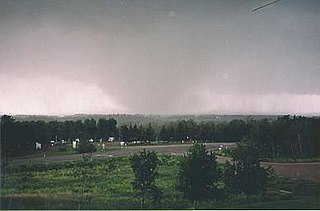
The Pine Lake tornado was a deadly tornado in central Alberta which occurred on Friday, July 14, 2000, and struck a campground and a trailer park. Twelve people were killed, making it the first deadly tornado in Canada since 1987, when an F4 tornado killed 27 people in Edmonton, Alberta and injured 300+.
Pine Lake is an unincorporated community in Red Deer County in the province of Alberta.

The Frog Lake Massacre was part of the Cree uprising during the North-West Rebellion in western Canada. Led by Wandering Spirit, young Cree men attacked officials, clergy and settlers in the small settlement of Frog Lake in the District of Saskatchewan in the North-West Territories on 2 April 1885. Nine settlers were killed in the incident.
Deer Lake First Nation is an Oji-Cree First Nations band government in Northern Ontario, located north of Red Lake, Ontario Canada. It is one of the few First Nations in Ontario to have signed Treaty 5. It is part of the Keewaytinook Okimakanak Council and the Nishnawbe Aski Nation. As of December, 2007, the First Nation had 1,072 registered members, of which their on-reserve population was 868.
The Manitoba Escarpment, or the Western Manitoba Uplands, are a range of hills along the Saskatchewan-Manitoba border. The eastern slopes of the range are considered to be a scarp. They were created by glacial scouring and formed the western shore of prehistoric Lake Agassiz.

Sandy Lake First Nation is an independent Oji-Cree First Nations band government. The First Nations community, in the west part of Northern Ontario, is located in the Kenora District, 227 km (141 mi) northeast of Red Lake, Ontario. Its registered population in June 2007 was 2,474. As of December 2015 the total registered population reached 3,034. Sandy Lake First Nation maintains an affiliation with Nishnawbe Aski Nation, as a signatory to the Treaty 5.
The Sakāwithiniwak or Woodland Cree, are a Cree people, calling themselves Nîhithaw in their own dialect of the language. They are the largest indigenous group in northern Alberta and are an Algonquian people. Prior to the 18th century, their territory extended west of Hudson Bay, as far north as Churchill. Although in western Northern Saskatchewan and Manitoba, by the 18th century, they acted as middlemen in trade with western tribes. After acquiring guns through trade, they greatly expanded their territory and drove other tribes further west and north.
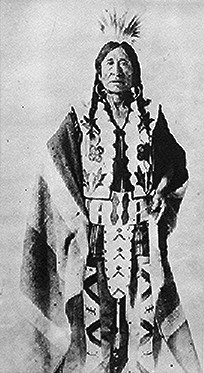
Asiniiwin, translated Rocky Boy or Stone Child, was an important Chippewa leader who was chief of a band in Montana in the late 19th century and early 20th century. His advocacy for his people helped gain the establishment of what is called Rocky Boy's Indian Reservation in his honor. Formed from part of Fort Assiniboine, which was closed, it is located in Hill and Chouteau counties in north central Montana.
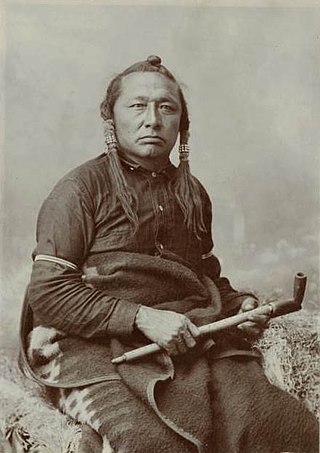
Little Bear was a Cree leader who lived in the District of Alberta, Idaho Territory, Montana Territory, and District of Saskatchewan regions of Canada and the United States, in the 19th and early 20th centuries. He is known for his participation in the 1885 North-West Rebellion, which was fought in Alberta and Saskatchewan.
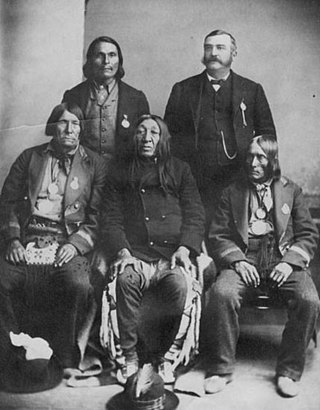
Ahtahkakoop (c. 1816 – 1896) was a Chief of the House Cree (Wāskahikaniwiyiniwak) division of the Plains Cree, who led his people through the transition from hunter and warrior to farmer, and from traditional indigenous spiritualism to Christianity during the last third of the 19th century.
The Iron Confederacy or Iron Confederation was a political and military alliance of Plains Indians of what is now Western Canada and the northern United States. This confederacy included various individual bands that formed political, hunting and military alliances in defense against common enemies. The ethnic groups that made up the Confederacy were the branches of the Cree that moved onto the Great Plains around 1740, the Saulteaux, the Nakoda or Stoney people also called Pwat or Assiniboine, and the Métis and Haudenosaunee. The Confederacy rose to predominance on the northern Plains during the height of the North American fur trade when they operated as middlemen controlling the flow of European goods, particularly guns and ammunition, to other Indigenous nations, and the flow of furs to the Hudson's Bay Company (HBC) and North West Company (NWC) trading posts. Its peoples later also played a major part in the bison (buffalo) hunt, and the pemmican trade. The decline of the fur trade and the collapse of the bison herds sapped the power of the Confederacy after the 1860s, and it could no longer act as a barrier to U.S. and Canadian expansion.
The Little Pine First Nation is a Plains Cree First Nations band government in Saskatchewan, Canada. Their reserves include:
